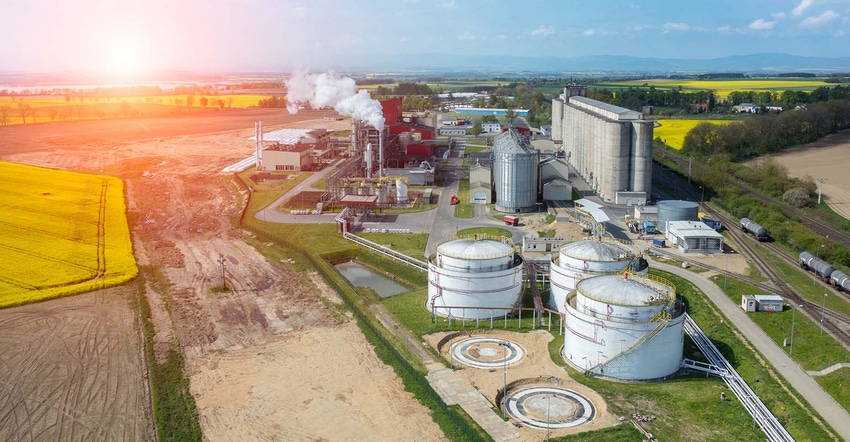
The carbon footprint of corn ethanol shrunk by 23% between 2005 and 2019 as farmers and ethanol producers adopted new technologies and improved efficiency, according to a new analysis published in the academic journal Biofuels Bioproducts and Biorefining by scientists at the Department of Energy’s Argonne National Laboratory. By 2019, the researchers found, corn ethanol was reducing lifecycle greenhouse gas emissions by 44-52% compared to gasoline.
Since 2000, corn ethanol production in the United State has increased significantly – from 1.6 to 15 billion gallons – due to supportive biofuel policies. In its study, the Argonne laboratory conducted a retrospective analysis of the changes in U.S. corn ethanol greenhouse gas emission intensity, sometimes known as carbon intensity, over the 15 years from 2005 to 2019, showing a significant decrease of 23%.
This is due to several factors, the analysis explains. Corn grain yield has increased continuously, reaching 168 bushels/acre or a 15% increase while fertilizer inputs per acre have remained constant, resulting in decreased intensities of fertilizer inputs with a 7% and 18% reduction in nitrogen and potash use per bushel of corn grain harvested, respectively. The study also found a 14% reduction per bushel in farming energy use.
The analysis also found a 6.5% increase in ethanol yield, from 2.70 to 2.86 gal/bushel corn and a 24% reduction in ethanol plant energy use, from 32 000 to 25 000 Btu/gal ethanol also helped reduce the carbon intensity.
“Our study shows that while the corn ethanol industry has experienced significant volume expansion, it has reduced the GHG intensity of corn ethanol through improved U.S. corn farming and ethanol biorefinery operations. Corn yield has increased, and chemical and energy use intensities of corn farming have decreased. In ethanol biorefineries, ethanol yield has increased, and energy use has decreased significantly,” according to the researchers. “Biofuels, including corn ethanol, can play a critical role in the U.S. desire for deep decarbonization of its economy.”
The researchers also determined that corn ethanol alone reduced transportation-related GHG emissions by nearly 550 million metric tons between 2005 and 2019. These findings are consistent with other research published earlier this year, which found corn ethanol offers an average GHG savings of 46% and the use of all biofuels (i.e., ethanol, renewable diesel, biodiesel, biogas, etc.) between 2008 and 2020 reduced GHG emissions by 980 million metric tons.
Further, the study authors note that “there has been a growing interest in further reducing the overall CI of crop‐based biofuels by cutting down the GHG emissions of biofuel feedstock, which correlates significantly with agronomic practices and chemical and energy inputs in individual farms. Proposals are being made about incentivizing low‐carbon biofuel feedstocks in U.S. fuel regulatory programs to promote sustainable farming practices. This will offer further opportunities to advance the sustainability of farming and reduce biofuel CIs.”
Low-carbon solution
Commenting on the new research, Renewable Fuels Association President and CEO Geoff Cooper says the new study adds to a growing body of scientific evidence that proves today’s corn ethanol is playing a major role in decarbonizing the nation’s transportation fuels and combatting climate change.
“The researchers found that modern corn ethanol cuts GHG emissions by half compared to gasoline and underscored that the contribution of land-use change to total emissions is estimated to be relatively small, based on real-world experience and empirical data, compared to the levels that had been theorized toward the beginning of the timeframe examined,” Cooper says.
“Continuous improvements in farming and biofuel production technology have helped establish ethanol as a true low-carbon fuel that is available here and now to clean up our nation’s liquid fuels,” Cooper adds. “And, as acknowledged by these researchers, those improvements will continue; with the adoption of new and emerging technologies, we expect corn ethanol can be a net carbon-neutral or carbon-negative fuel by the end of this decade.”
Brian Jennings, CEO of the American Coalition for Ethanol, says the evidence is mounting that agriculture and ethanol can and should be part of the solution to significantly reduce GHG emissions, both in the immediate future and long term.
“When modelers provide credit for soil carbon sequestration, corn ethanol will approach net-negative emissions territory,” Jennings explains. “Further, with the adoption of carbon capture and sequestration, ethanol will be the only transportation energy source that can credibly say it has the ability to reach net-negative carbon intensity in the future.”
RFA urges the Environmental Protection Agency to incorporate the Argonne results and other recent research as the agency considers updating its 12-year old GHG analysis of ethanol and other renewable fuels.
About the Author(s)
You May Also Like






